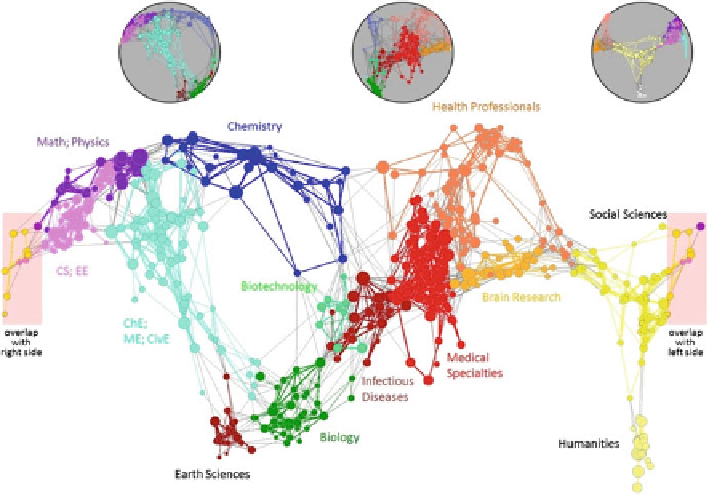Information Technology Reference
In-Depth Information
Fig. 8.17
The UCSD map of science. Each node in the map is a cluster of journals. The clustering
was based on a combination of bibliographic couplings between journals and between keywords.
Thirteen regions are manually labeled (Reproduced with permission)
and Kevin Boyack came to the conclusion that research evaluation requires maps
with clusters at the article level rather than at the journal level.
The UCSD map was generated for UCSD to show their research strengths and
competencies. Although the discipline-level map characterizes the global structure
of scientific literature, much more details are necessary to quantify research
strengths at UCSD. The similar procedure was applied to generate an article-
level map as opposed to a journal-level map. Clusters of articles were calculated
based on co-citations. In addition to the discipline-level circle map, the paper-level
clustering provides much more detailed classification information. In contrast to the
554 journal clusters, the paper-level clustering of co-cited references identified over
84,000 clusters, which are called paradigms (Fig.
8.18
).
In a 2009 Scientometrics paper (Boyack
2009
), Boyack described how a
disciplinary-level map can be used for collaboration. He collected 1.35 million
papers from 7,506 journals and 1,206 conference proceedings. These papers contain
29.23 million references. Similarities between references were calculated in terms
of bibliographic coupling. These reference-level similarities were then aggregated to
obtain similarities between journals. For each journal, the top 15 most similar jour-
nals in terms of bibliographic coupling were retained for generating the final map.
The map layout step served two purposes: one is to optimize the arrangement
of the journals so that the distance between journals on the map is proportional to

Search WWH ::

Custom Search